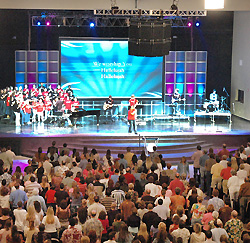Last year, a worship leader named Jordan Richmond wrote a post on Thom Rainer’s blog. The post is entitled, “How Loud Should Our Church Music Be?” and it incited no small number of comments. In fact, if you have some time, go read the comments; some are quite amusing.
I think the article raises an important point, and is a good starting point for discussion. However, I do take issue with a few things he said.
His premise is that as a worship leader, he’s not unfamiliar with volume complaints. But how do you solve that? While on vacation at Disney World, he pulled out his trusty iPhone and measured the SPL at the shows he saw there. He came up with 75 dB [sic] as “the answer” to the correct volume.
I put [sic] at the end of 75 dB because he didn’t specify A- or C-weighting, and that makes a big difference. But that’s not the only thing.
Uncalibrated iPhones with free SPL apps cause more harm than good. Now that every member of your congregation has an SPL meter in their pocket, the number of people telling us they have proof it’s too loud is going way up. The problem is, an uncalibrated iPhone or Android phone is not at all accurate.
When I attempted a calibration on mine (using an actual SPL calibrator), I found my (paid and “professional”) SPL meter was off by −10 dB. That translates to about double the perceived volume. Even after I calibrated it, it’s not truly calibrated, it’s just close.
So before we start talking absolute numbers, let’s be sure we are using an actual and calibrated SPL meter. Even those are not super-helpful in determining the appropriate volume, but we’ll get to that shortly.
I respectfully disagree that there is one perfect volume for all venues. Shoot, I won’t even agree that there is one perfect volume for one venue. Our church’s average and peak volumes vary by a good 5-8 dB depending on the song set, arrangements and band makeup.
Some churches demand loud, energetic worship. Others prefer quieter, more contemplative music. This is OK!! I get really frustrated when I hear people talking about setting a universal standard for music levels.
If you like quieter music, find a church that does quieter music. If you like it loud, go to a loud church. But don’t go to a church known for loud music and complain it’s too loud! Likewise, if you’re a worship leader or FOH person, don’t go to a quiet church and try to recreate a Hillsong concert. That’s just—dare I say it?—stupid.
I would also disagree that Disney is the standard. Sure, Disney gets a lot of things right. I like going there when I can. I think we can learn a lot from how they do things; they create great experiences for their guests. But to say that the volume of their shows is the ideal volume is a bit of a stretch. First of all, I suspect the actual level was higher than 75 dB. Second, it’s totally different material.
Realistically, I think you could find just as many people who think Disney shows are too quiet as those who think it’s too loud. And you can probably say the same for many churches. So I guess this another way of re-stating my previous point. Finding the appropriate volume for a particular church is a tricky thing, and it’s a very individual thing.





















